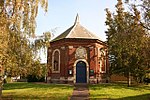Postland railway station

Postland railway station was a station on the Great Northern and Great Eastern Joint Railway in Crowland, Lincolnshire, which is now closed. It took its name from the Postland estate, owned by the Marquess of Exeter. It originally opened in 1867, and remained open to passengers until 1961. Services to Cambridge and Doncaster ran from here. In July 1936, a serious accident took place at the station, involving Ex-GNR Class H4 2-6-0 No. 2764.Postland station was closed permanently in 1965. Train passengers from Crowland and the surrounding area must now use either Spalding railway station or Peterborough railway station. The closure of the station was not related to the Beeching axe of the same era.The station building and former signal box now lie on the B1166, which runs from Crowland to Throckenholt, and the station building has now been converted into a house.
Excerpt from the Wikipedia article Postland railway station (License: CC BY-SA 3.0, Authors, Images).Postland railway station
Hull's Drove, South Holland Crowland
Geographical coordinates (GPS) Address Nearby Places Show on map
Geographical coordinates (GPS)
| Latitude | Longitude |
|---|---|
| N 52.6953 ° | E -0.0901 ° |
Address
Hull's Drove
Hull's Drove
PE6 0JU South Holland, Crowland
England, United Kingdom
Open on Google Maps











